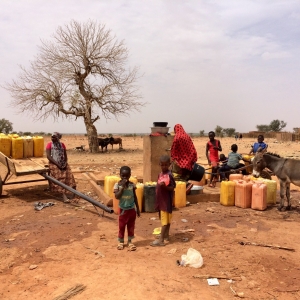Federal Water Tap, June 8: EPA Rule Limits Use of Clean Water Act to Block Energy Infrastructure
The Rundown
The EPA narrows use of Section 401 of the Clean Water Act. President Trump signs an order to speed up or abridge environmental review. The Senate passes an Indian water rights settlement bill. The Army Corps forecasts more record-high water levels for two of the Great Lakes. Environment agencies in Canada and the United States submit an annual Great Lakes report card. EPA wants water temperature limits in the Columbia and Lower Snake rivers to protect salmon. Federal officials discuss sewage pollution in the Tijuana River. NOAA forecasts a smaller Gulf of Mexico dead zone than last year. And lastly, the EPA targets early September for finalizing new rules for lead in drinking water.
“High water will continue until we see dry conditions over months and years.” — Deanna Apps, a physical scientist with the Army Corps of Engineers’ Detroit District, talking about record-high water levels on the Great Lakes. The Army Corps is forecasting that lakes Huron and Michigan will set all-time highs this summer. The lakes, which are hydrologically connected, set monthly highs every month in 2020 so far.
By the Numbers
14: Members appointed to the revived Great Lakes Advisory Board, a federal advisory committee that will provide guidance on environmental restoration in the watershed and a water quality agreement with Canada. The board’s charter had expired in 2018. (EPA)
$5 million: Grant funding awarded to 12 research projects to study water quality and quantity for irrigation. Projects include in-stream sensors to detect changes in nitrate, measuring pharmaceuticals in recycled water, and reusing water, nutrients, and energy from livestock wastewater. (USDA)
News Briefs
EPA Constrains State Permitting Authority
Seeking to corral what he called “abuses” of power by states, Andrew Wheeler, the head of the U.S. Environmental Protection Agency, announced changes to the Clean Water Act permitting process. The changes will affect state and tribal regulation of pipeline, energy, and transportation projects.
States are allowed to weigh in on major infrastructure projects through Section 401 of the Clean Water Act. The section gives states and tribes the power to add conditions or veto projects if they will pollute waterways.
Wheeler said the abuses occur when states reject projects using Section 401 authority for reasons that do not involve water quality. He mentioned energy infrastructure projects in the Pacific Northwest and New York state as examples of abuse. A liquefied natural gas export terminal at Jordan Cove, in Oregon, was vetoed this way, as was the Constitution natural gas pipeline, in New York.
The new rule “prevents states from using the Clean Water Act in ways that hold our nation’s energy infrastructure hostage,” Wheeler said. Decisions must be restricted to water pollution, not expanded to wetlands damage or climate change considerations.
The new rule also set a one-year time limit on state reviews. If a state fails to complete its review within a year, the requirement is waived.
What is the effect of the rule? Lawyers with Beveridge and Diamond say that, as for many EPA decisions, this ruling could be challenged in court. They also speculate that the time limits could result in more vetoes if states and tribes cannot produce sufficient evidence in one year to certify the project.
Faster Environmental Review
President Trump signed an executive order to ease the burden of environmental review for federal projects, in order to boost economic growth during the coronavirus pandemic.
The head of federal agencies are to use “emergency procedures, statutory exemptions, categorical exclusions, analyses that have already been completed, and concise and focused analyses” to speed the completion of transportation, public works, and energy projects.
The order follows a directive that Trump issued in May to federal agencies to relax regulations that could “inhibit economic recovery,” as long as the actions were within the scope of the law.
Tijuana River Pollution Meeting
Local, state, and federal agencies held a virtual meeting to discuss sewage pollution in the Tijuana River.
Congress approved $300 million for wastewater treatment projects that improve water quality in the river, which begins in Mexico before crossing into the United States just north of Tijuana.
An EPA presentation suggests that project evaluation will soon pick up speed. A group of stakeholders – Customs and Border Protection, Navy, Army Corps of Engineers, the cities of Coronado, San Diego, Imperial Beach, and Chula Vista, among others – will meet bimonthly starting in July. A technical committee will assess the engineering options, which include expanded treatment capacity at an existing plant, new treatment facilities, and more reuse in Mexico.
Senate Passes Indian Water Rights Bill
The Senate approved legislation that deals with a number of Indian water rights claims.
The bill approves a water rights agreement between the Navajo Nation and the state of Utah. It extends the authorization for a federal fund dedicated to Indian water rights settlements.
The bill increases authorized federal funding for a regional water system in the Pojoaque basin of New Mexico by $137 million. It also orders a federal study of a multipurpose dam that would be used to satisfy water rights claims by the Kickapoo Tribe of Kansas.
Studies and Reports
EPA Wants Temperature Limits For Columbia and Lower Snake Rivers
To protect salmon, the EPA is proposing to establish temperature limits for the waters of the Columbia and Lower Snake rivers, a move that would affect the operation of federal and local dams.
Warm water can be fatal to salmon. The proposed standards vary depending on the stretch of the river and the season, but all seek to keep water temperatures below 68 degrees Fahrenheit, the point at which salmon become stressed. The rivers are in Oregon and Washington.
Public comments on the standards are being accepted through July 21. Send them to ColumbiaRiverTMDL@epa.gov.
Great Lakes Water Levels
Of the Great Lakes, only lakes Huron and Michigan are expected to set all-time highs this summer, a reversal from last year when the other three main lakes set record highs.
The lake-level forecast comes from the Army Corps of Engineers.
State of the Great Lakes
Environment agencies from Canada and the United States submitted their annual report card on the Great Lakes.
Overall, the lakes are in fair health and the trend line is flat.
On a more detailed level, the report looks at nine indicators. Trend lines for seven of the indicators were unchanged. Invasive species are getting worse, while toxic chemicals show signs of improvement.
Gulf of Mexico Dead Zone Forecast
NOAA scientists are forecasting that the annual low-oxygen dead zone in the Gulf of Mexico will be larger than the long-term average, but smaller than it was in 2019.
The dead zone, which is fatal to fish and marine life, is caused by excess nitrate in the Mississippi River watershed.
The forecast, compiled by merging the results of multiple computer models, estimates that the dead zone will span some 6,700 square miles. The probable range is between 3,900 and 9,500 square miles. Researchers will survey the Gulf later this summer to measure the actual size.
On the Radar
Lead and Copper Rule Publish Date
The U.S. Environmental Protection Agency is targeting September 4, 2020 as the date for signing a final revisions to federal rules for lead in drinking water.
The agency disclosed the date in a three-and-a-half-month contract extension for Cadmus Group, a consulting firm that is helping with the rule’s technical analysis.
House Hearing
On June 9, the House Committee on Energy and Commerce will discuss the disproportionate impact of the coronavirus pandemic on poor and minority communities.
Federal Water Tap is a weekly digest spotting trends in U.S. government water policy. To get more water news, follow Circle of Blue on Twitter and sign up for our newsletter.
Brett writes about agriculture, energy, infrastructure, and the politics and economics of water in the United States. He also writes the Federal Water Tap, Circle of Blue’s weekly digest of U.S. government water news. He is the winner of two Society of Environmental Journalists reporting awards, one of the top honors in American environmental journalism: first place for explanatory reporting for a series on septic system pollution in the United States(2016) and third place for beat reporting in a small market (2014). He received the Sierra Club’s Distinguished Service Award in 2018. Brett lives in Seattle, where he hikes the mountains and bakes pies. Contact Brett Walton





Leave a Reply
Want to join the discussion?Feel free to contribute!